
Illustrative Math Alignment: Grade 8 Unit 3
Functions and Volume
Lesson 12: How Much Will Fit?
Use the following Media4Math resources with this Illustrative Math lesson.
| Thumbnail Image | Title | Body | Curriculum Topic |
|---|---|---|---|
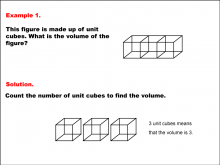
|
Math Example--Volume Concepts--Modeling Volume--Example 1 | Math Example--Volume Concepts--Modeling Volume--Example 1TopicVolume DescriptionThe image shows a rectangular prism made up of 3 unit cubes arranged in a single row. The example asks for the volume of the figure, and the solution involves counting the number of unit cubes. Example 1: The figure consists of 3 unit cubes. The caption reads: "Count the number of unit cubes to find the volume. 3 unit cubes means that the volume is 3." |
Volume |
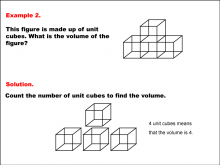
|
Math Example--Volume Concepts--Modeling Volume--Example 2 | Math Example--Volume Concepts--Modeling Volume--Example 2TopicVolume DescriptionThe image shows a figure made up of 4 unit cubes, with one cube stacked on top of another, forming an L-shape. The example asks for the volume, and the solution involves counting the cubes. Example 2: The figure consists of 4 unit cubes. The caption reads: "Count the number of unit cubes to find the volume. 4 unit cubes means that the volume is 4." |
Volume |
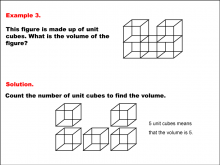
|
Math Example--Volume Concepts--Modeling Volume--Example 3 | Math Example--Volume Concepts--Modeling Volume--Example 3TopicVolume DescriptionThe image shows a figure made up of 5 unit cubes arranged in an irregular shape, with one cube raised above others. The example asks for the volume, and the solution involves counting the number of unit cubes. Example 3: The figure consists of 5 unit cubes. The caption reads: "Count the number of unit cubes to find the volume. 5 unit cubes means that the volume is 5." |
Volume |
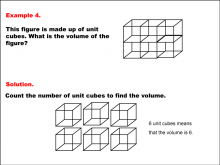
|
Math Example--Volume Concepts--Modeling Volume--Example 4 | Math Example--Volume Concepts--Modeling Volume--Example 4TopicFractions DescriptionThe image shows a rectangular prism made up of 6 unit cubes arranged in two layers (a top and bottom row). The example asks for the volume, and the solution involves counting all the cubes in both layers. Example 4: The figure consists of 6 unit cubes. The caption reads: "Count the number of unit cubes to find the volume. 6 unit cubes means that the volume is 6." |
Volume |
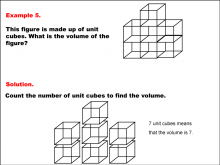
|
Math Example--Volume Concepts--Modeling Volume--Example 5 | Math Example--Volume Concepts--Modeling Volume--Example 5TopicFractions DescriptionThe image shows a 3D figure made up of unit cubes. The figure is stacked in a staggered manner, with some cubes placed directly on top of others. Below the figure, there is a breakdown showing the individual cubes counted to determine the volume. Example 5: The caption asks for the volume of the figure, which is made up of unit cubes. The solution involves counting the cubes to find the volume. |
Volume |
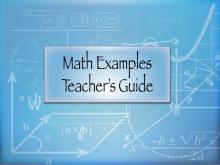
|
MATH EXAMPLES--Teacher's Guide: Surface Area | MATH EXAMPLES--Teacher's Guide: Surface Area
This Teacher's Guide provides an overview of the 24 worked-out examples that show how to calculate the surface area of different three-dimensional figures. This is part of a collection of teacher's guides. To see the complete collection of teacher's guides, click on this link. Note: The download is a PDF file.Related ResourcesTo see resources related to this topic click on the Related Resources tab above. |
Surface Area |

|
MATH EXAMPLES--Teacher's Guide: Volume | MATH EXAMPLES--Teacher's Guide: Volume
This set of tutorials provides 24 examples of how to find the volume of various 3-dimensional geometric figures. This is part of a collection of teacher's guides. To see the complete collection of teacher's guides, click on this link. Note: The download is a PDF file.Related ResourcesTo see resources related to this topic click on the Related Resources tab above. |
Volume |

|
MATH EXAMPLES--Volume | MATH EXAMPLES--Volume
This set of tutorials provides 24 examples of how to find the volume of various 3-dimensional geometric figures. NOTE: The download is a PPT file. |
Volume |
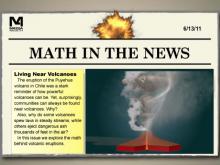
|
Math in the News: Issue 13--Living Near Volcanoes | Math in the News: Issue 13--Living Near Volcanoes
6/13/11. In this issue we explore the volcanic eruption in Chile that resulted in a huge plume of smoke and ash that was miles high. We explore the viscosity of lava that makes such eruptions possible. This is part of the Math in the News collection. To see the complete collection, click on this link. Note: The download is a PPT file.Related ResourcesTo see resources related to this topic click on the Related Resources tab above. |
Volume |
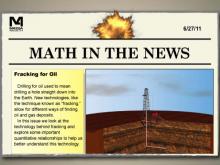
|
Math in the News: Issue 15--Fracking for Oil | Math in the News: Issue 15--Fracking for Oil
6/27/11. In this issue we look at the technology of hydraulic fracking. In particular, we estimate the amount of drilling required for such wells. This is part of the Math in the News collection. To see the complete collection, click on this link. Note: The download is a PPT file.Related ResourcesTo see resources related to this topic click on the Related Resources tab above. |
Volume |
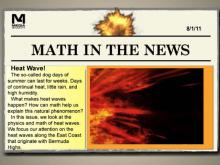
|
Math in the News: Issue 20--Heat Wave! | Math in the News: Issue 20--Heat Wave!
8/1/11. In this issue we look at the physics of air pressure and the forces that give rise to heat waves. This is part of the Math in the News collection. To see the complete collection, click on this link. Note: The download is a PPT file.Related ResourcesTo see resources related to this topic click on the Related Resources tab above. |
Data Analysis |
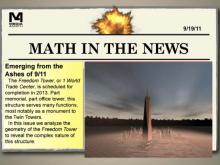
|
Math in the News: Issue 27--Emerging from the Ashes of 9/11 | Math in the News: Issue 27--Emerging from the Ashes of 9/11
9/19/11. To commemorate the 10-year anniversary of the 911, we look at the geometry and architecture of the Freedom Tower, currently under construction. This is part of the Math in the News collection. To see the complete collection, click on this link. Note: The download is a PPT file.Related ResourcesTo see resources related to this topic click on the Related Resources tab above. |
3-Dimensional Figures |
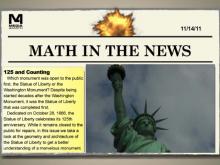
|
Math in the News: Issue 35--125 and Counting | Math in the News: Issue 35--125 and Counting
11/14/11. In this issue we commemorate the 125th anniversary of the Statue of Liberty. We also look at the geometry and architecture of this monument. This is part of the Math in the News collection. To see the complete collection, click on this link. Note: The download is a PPT file.Related ResourcesTo see resources related to this topic click on the Related Resources tab above. |
Surface Area and Volume |
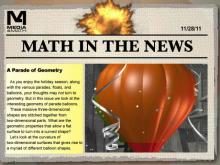
|
Math in the News: Issue 37--A Parade of Geometry | Math in the News: Issue 37--A Parade of Geometry
11/28/11. In this issue we look at the geometry of parade balloons. This is part of the Math in the News collection. To see the complete collection, click on this link. Note: The download is a PPT file.Related ResourcesTo see resources related to this topic click on the Related Resources tab above. |
Surface Area and Volume |

|
Math in the News: Issue 38--December 7, 1941 | Math in the News: Issue 38--December 7, 1941
12/7/11. In this issue we look at the heroic work of salvaging and retrofitting many of the ships sunk during the attack on Pearl Harbor. This is part of the Math in the News collection. To see the complete collection, click on this link. Note: The download is a PPT file.Related ResourcesTo see resources related to this topic click on the Related Resources tab above. |
Surface Area and Volume |
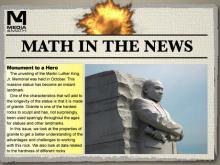
|
Math in the News: Issue 39--Monument to a Hero | Math in the News: Issue 39--Monument to a Hero
12/12/11. In this issue we look at the MLK Memorial and the special properties of granite that presented some design challenges in the construction of the statue. This is part of the Math in the News collection. To see the complete collection, click on this link. Note: The download is a PPT file.Related ResourcesTo see resources related to this topic click on the Related Resources tab above. |
Surface Area and Volume |
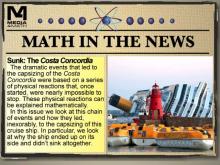
|
Math in the News: Issue 44--Sunk: The Costa Concordia | Math in the News: Issue 44--Sunk: The Costa Concordia
January 2012. In this issue of Math in the News we analyze how the Costa Concordia sank. This is part of the Math in the News collection. To see the complete collection, click on this link. Note: The download is a PPT file.Related ResourcesTo see resources related to this topic click on the Related Resources tab above. |
Surface Area and Volume |
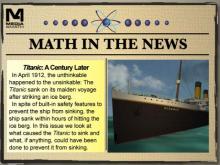
|
Math in the News: Issue 53--Titanic: A Century Later | Math in the News: Issue 53--Titanic: A Century Later
April 2012. In this issue of Math in the News we analyze the sinking of the Titanic. It has been a hundred years, yet the story of the sinkin g of the Titanic still fascinates. This is part of the Math in the News collection. To see the complete collection, click on this link. Note: The download is a PPT file.Related ResourcesTo see resources related to this topic click on the Related Resources tab above. |
Surface Area and Volume |

|
Math in the News: Issue 56--The Freedom Tower | Math in the News: Issue 56--The Freedom Tower
May 2012. In this issue of Math in the News we look at the architecture of the Freedom Tower, now that it has become the tallest building in NYC. This is part of the Math in the News collection. To see the complete collection, click on this link. Note: The download is a PPT file.Related ResourcesTo see resources related to this topic click on the Related Resources tab above. |
3-Dimensional Figures |

|
Math in the News: Issue 73--County Fairs and Funnel Cakes | Math in the News: Issue 73--County Fairs and Funnel Cakes
August 2013. In this issue we look at the geometry of funnel cakes. You'll like the sweet results. This is part of the Math in the News collection. To see the complete collection, click on this link. Note: The download is a PPT file.Related ResourcesTo see resources related to this topic click on the Related Resources tab above. |
Surface Area and Volume |

|
Math in the News: Issue 8--Tornado Damage | Math in the News: Issue 8--Tornado Damage
5/9/11. In this issue we look at tornado season. In particular we study why the swirling winds of a tornado are so damaging. This is part of the Math in the News collection. To see the complete collection, click on this link. Note: The download is a PPT file.Related ResourcesTo see resources related to this topic click on the Related Resources tab above. |
Data Analysis |
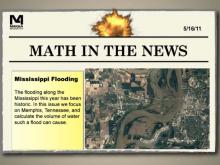
|
Math in the News: Issue 9--Mississippi Floods | Math in the News: Issue 9--Mississippi Floods
5/16/11. In this issue we look at the flooding along the Mississippi. In particular we analyze the flooding along Memphis, Tennessee. We develop a model for predicting the amount of flooding. This is part of the Math in the News collection. To see the complete collection, click on this link. Note: The download is a PPT file.Related ResourcesTo see resources related to this topic click on the Related Resources tab above. |
Volume |
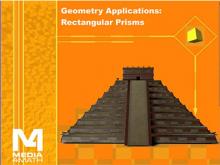
|
Promethean Flipchart: Geometry Applications: 3D Geometry 1 | Rectangular Prisms. Mayan pyramids are essentially stacks of rectangular prisms. The volume of each successive level is a percentage decrease of its lower neighbor. This introduces the notion of a geometric sequence and series, including an infinite series. Note: The download for this resources is the Promethean Flipchart. For access to the full video [Geometry Applications: 3D Geometry, Segment 2: Pyramids]: https://media4math.com/library/geometry-applications-3d-geometry-segment-2-pyramids This video includes a Video Transcript [Video Transcript: Geometry Applications: 3D Geometry, Segment 2: Pyramids]: https://www.media4math.com/library/video-transcript-geometry-applications-3d-geometry-segment-2-pyramids |
Applications of 3D Geometry |
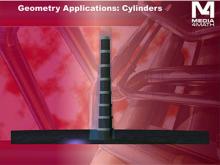
|
Promethean Flipchart: Geometry Applications: 3D Geometry 2 | The Shanghai Tower in China is a stack of cylindrical shapes, where each successive layer is a percentage decrease of its lower neighbor. As with the previous section, this introduces the notion of a geometric sequence and series. Note: The download for this resources is the Promethean Flipchart. To access the full video [Geometry Applications: 3D Geometry, Segment 3: Cylinders]: https://media4math.com/library/geometry-applications-3d-geometry-segment-3-cylinders This video includes a Video Transcript [Video Transcript: Geometry Applications: 3D Geometry, Segment 3: Cylinders]: https://www.media4math.com/library/video-transcript-geometry-applications-3d-geometry-segment-3-cylinders
|
Applications of 3D Geometry |

|
Video Transcript: Algebra Applications: Rational Functions, Segment 2: Biology | Video Transcript: Algebra Applications: Rational Functions, Segment 2: Biology
This is the transcript for the video of same title. Video contents: All living things take up a certain amount of space, and therefore have volume. They also have a certain amount of surface area. The ratio of surface area to volume, which is a rational function, reveals important information about the organism. Students look at different graphs of these functions for different organisms. |
Rational Expressions and Rational Functions and Equations |

|
Video Transcript: Geometry Applications--Volume of a Pyramid | Video Transcript: Geometry Applications--Volume of a Pyramid
This is the transcript for video entitled: "Geometry Applications--Volume of a Pyramid." This is part of a collection of video transcript from the Geometry Applications video series. To see the complete collection of transcripts, click on this link. Note: The download is a PDF file. Video Transcript LibraryTo see the complete collection of video transcriptsy, click on this link. Video LibraryTo see the complete collection of videos in the Video Library, click on this link. |
Pyramids |

|
Video Transcript: Geometry Applications: 3D Geometry | Video Transcript: Geometry Applications: 3D Geometry
This is the transcript for the video of same title. Video contents: In this program we explore the properties of three-dimensional figures. We do this in the context of two real-world applications. In the first, we look at the three-dimensional structure of Mayan pyramids. These stair-step structures provide a unique opportunity to also explore sequences and series. In the second application we look at the Shanghai Tower as an example of cylindrically shaped structures. |
3-Dimensional Figures and Applications of 3D Geometry |

|
Video Transcript: Geometry Applications: 3D Geometry, Segment 1: Introduction | Video Transcript: Geometry Applications: 3D Geometry, Segment 1: Introduction
This is the transcript for the video of same title. Video contents: We visit ancient Greece to learn about the Platonic Solids. This provides an introduction to the more general topic of three-dimensional figures. This is part of a collection of video transcript from the Geometry Applications video series. To see the complete collection of transcripts, click on this link. Note: The download is a PDF file. Video Transcript LibraryTo see the complete collection of video transcriptsy, click on this link. |
3-Dimensional Figures and Applications of 3D Geometry |

|
Video Transcript: Geometry Applications: 3D Geometry, Segment 2: Pyramids | Video Transcript: Geometry Applications: 3D Geometry, Segment 2: Pyramids
This is the transcript for the video of same title. Video contents: Rectangular Prisms. Mayan pyramids are essentially stacks of rectangular prisms. The volume of each successive level is a percentage decrease of its lower neighbor. This introduces the notion of a geometric sequence and series, including an infinite series. |
3-Dimensional Figures and Applications of 3D Geometry |

|
Video Transcript: Geometry Applications: 3D Geometry, Segment 3: Cylinders | Video Transcript: Geometry Applications: 3D Geometry, Segment 3: Cylinders
This is the transcript for the video of same title. Video contents: The Shanghai Tower in China is a stack of cylindrical shapes, where each successive layer is a percentage decrease of its lower neighbor. As with the previous section, this introduces the notion of a geometric sequence and series. |
3-Dimensional Figures and Applications of 3D Geometry |
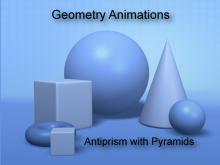
|
VIDEO: 3D Geometry Animation: Antiprisms 2 | VIDEO: 3D Geometry Animation: Antiprism Folding Out into Two Pyramids
This is part of a series of video animations of three-dimensional figures. These animations show different views of these figures: top, side, and bottom. Many of these figures are a standard part of the geometry curriculum and being able to recognize them is important. — CLICK THE PREVIEW BUTTON TO SEE THE VIDEO ANIMATION —Study these animations to learn the basic properties of these 3D figures. In particular, make a note of their sides, edges, and vertices. Look for any symmetries they have. Look for polygon shapes that are familiar. Finally, think of real-world examples that use these figures. Below we also include information about Platonic solids and 2D nets of these 3D figures. To get a better understanding of these 3D figures, study these basic forms. |
3-Dimensional Figures |
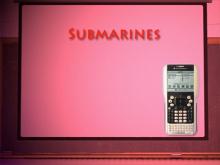
|
VIDEO: Algebra Applications: Rational Functions, 1 | VIDEO: Algebra Applications: Rational Functions, 1
TopicRational Functions DescriptionExplains submarine pressure and volume relationships using rational functions, illustrating depth impacts on vessel integrity and scuba safety. Relevance: This video provides a practical perspective on Rational Functions, making abstract concepts more accessible through real-world applications. |
Rational Expressions and Rational Functions and Equations |

|
VIDEO: Algebra Applications: Rational Functions, 2 | VIDEO: Algebra Applications: Rational Functions, 2
TopicRational Functions DescriptionExamines surface area to volume ratios in animals using rational functions, connecting these ratios to evolutionary adaptations in different climates. Relevance: This video provides a practical perspective on Rational Functions, making abstract concepts more accessible through real-world applications. |
Rational Expressions and Rational Functions and Equations |
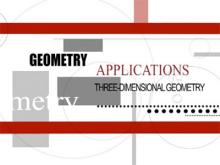
|
VIDEO: Geometry Applications: 3D Geometry | VIDEO: Geometry Applications: 3D Geometry
Topic3D Geometry |
3-Dimensional Figures and Applications of 3D Geometry |

|
VIDEO: Geometry Applications: 3D Geometry, 1 | VIDEO: Geometry Applications: 3D Geometry, 1
Topic3D Geometry DescriptionThis segment introduces Platonic solids, including tetrahedron, cube, and dodecahedron, emphasizing their congruent edges, vertices, and angles. It connects these geometric figures to both natural and man-made structures, setting the stage for exploring 3D geometry applications. This video offers a comprehensive look at the mathematical concepts behind 3D Geometry. Students will gain insights into practical applications and theoretical understanding of the topic, enhancing their ability to visualize and apply these concepts. |
3-Dimensional Figures and Applications of 3D Geometry |
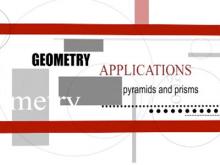
|
VIDEO: Geometry Applications: 3D Geometry, 2 | VIDEO: Geometry Applications: 3D Geometry, 2
Topic3D Geometry DescriptionThis segment explores pyramids, particularly Mayan and Egyptian structures, to distinguish rectangular and square bases. It discusses the volume of truncated pyramids using proportional relationships and introduces the concept of tiered volume reduction through geometric sequences. This video offers a comprehensive look at the mathematical concepts behind 3D Geometry. Students will gain insights into practical applications and theoretical understanding of the topic, enhancing their ability to visualize and apply these concepts. |
3-Dimensional Figures, Pyramids and Applications of 3D Geometry |
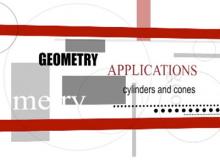
|
VIDEO: Geometry Applications: 3D Geometry, 3 | VIDEO: Geometry Applications: 3D Geometry, 3
Topic3D Geometry DescriptionThis segment examines cylinders, using the Shanghai Tower as a case study. It highlights how adjustments to height and radius affect volume and surface area, demonstrating these principles with geometric calculations and their architectural applications in energy efficiency. This video offers a comprehensive look at the mathematical concepts behind 3D Geometry. Students will gain insights into practical applications and theoretical understanding of the topic, enhancing their ability to visualize and apply these concepts. |
3-Dimensional Figures, Cylinders and Applications of 3D Geometry |

|
VIDEO: Geometry Applications: 3D Geometry, Pyramid Volume | VIDEO: Geometry Applications: 3D Geometry, Pyramid Volume
Topic3D Geometry |
Pyramids |
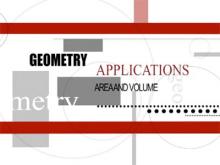
|
VIDEO: Geometry Applications: Area and Volume | VIDEO: Geometry Applications: Area and Volume
TopicArea and Volume |
Applications of Surface Area and Volume, Surface Area and Volume |

|
VIDEO: Geometry Applications: Area and Volume, 1 | VIDEO: Geometry Applications: Area and Volume, 1
TopicArea and Volume DescriptionThis segment explores the concept of density, using the Titanic to demonstrate buoyancy and the relationship between mass and volume. It introduces direct variation, rational functions, and how these principles apply to ship design for optimal floating capacity. |
Applications of Surface Area and Volume, Surface Area and Volume |

|
VIDEO: Geometry Applications: Area and Volume, 1 | VIDEO: Geometry Applications: Area and Volume, 1
TopicArea and Volume DescriptionThis segment explores the concept of density, using the Titanic to demonstrate buoyancy and the relationship between mass and volume. It introduces direct variation, rational functions, and how these principles apply to ship design for optimal floating capacity. |
Applications of Surface Area and Volume, Surface Area and Volume |

|
VIDEO: Geometry Applications: Area and Volume, 2 | VIDEO: Geometry Applications: Area and Volume, 2
TopicArea and Volume DescriptionThis segment focuses on surface area, using the Louvre Pyramid to highlight geometric tessellations and triangular net calculations. It explains the surface area formula for pyramids and how these calculations are applied in architectural design and material efficiency. |
Applications of Surface Area and Volume, Surface Area and Volume |
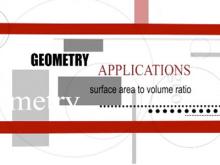
|
VIDEO: Geometry Applications: Area and Volume, 3 | VIDEO: Geometry Applications: Area and Volume, 3
TopicArea and Volume DescriptionThis segment explores the surface area-to-volume ratio using the Citigroup Building as an example. It discusses how this ratio impacts energy efficiency in buildings and compares it to natural examples like polar bears and snakes for context. |
Applications of Surface Area and Volume, Surface Area and Volume |